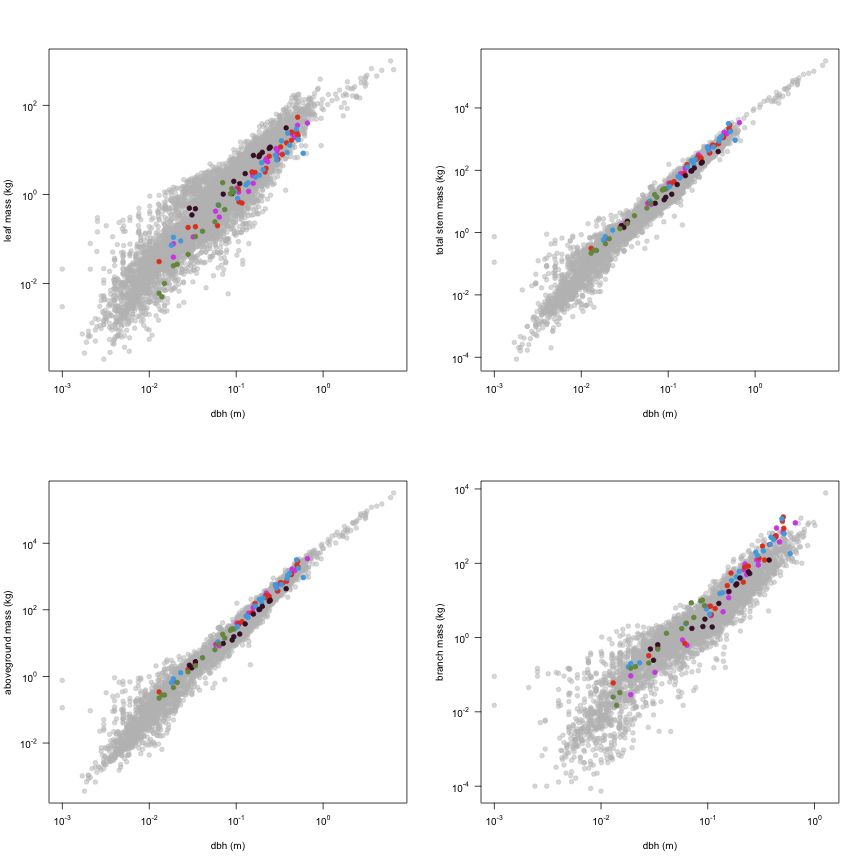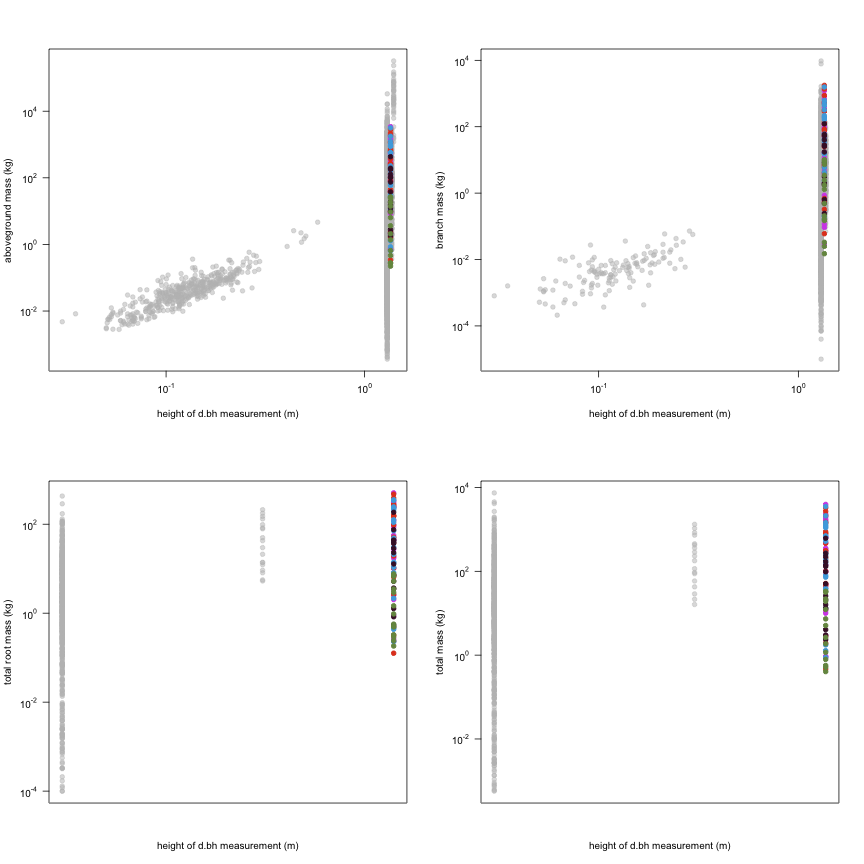-
Notifications
You must be signed in to change notification settings - Fork 19
Whittaker1974
Data contributor: Matthew A. Vadeboncoeur, John J. Battles
Email: matt.vad@unh.edu, jbattles@berkeley.edu
Address:
- Earth Systems Research Center, University of New Hampshire, 8 College Road, Durham, NH 03824, USA
- Dept of Environmental Science, Policy, & Management, University of California, Berkeley, CA 94720, USA
Citation: Whittaker RH, Bormann FH, Likens GE and Siccama TG (1974). 'The Hubbard Brook Ecosystem Study: Forest Biomass and Production.' Ecological Monographs, 44(2), pp. 233-254.
DOI: 10.2307/1942313
Abstract: A small watershed in the White Mountains of New Hampshire bearing mesophytic, cool-temperate, broadleaf-deciduous forests was studied. Acer saccharum, Betula alleghaniensis, and Fagus grandifolia are dominant, but toward higher elevations Picea rubens also occurs and indicate the transition toward subalpine climate. The stands are young (following cutting in 1909-17) but contain older trees; stand composition is thought reasonably representative of the climax. For application of the Brookhaven system of forest dimension analysis, 93 sample trees of major species were cut and roots excavated in 1965. Acer pensylvanicum, a common understory species, was also studied. Mean dimensions of sample trees, and the constants for the system of logarithmic regressions relating volume, surface, mass, and growth to diameter at breast height and other independent variables, show decrease in tree sizes and height/diameter ratios toward higher elevations. Stand characteristics, based on application of the regressions to forest samples, show trends of decrease for the elevation belts from low to high: stem basal area 26.3, 23.7, and 22.0 m2/ha, weighted mean tree height 16.9, 16.7, and 10.8 m, weighted mean age 124, 95, and 83 yr, stem wood volume 176, 155, and 103 m-3/ha, aboveground biomass (dry matter) 162, 152, and 102 Mg/ha, estimated volume increment 379, 365, and 223 cm3/m2/yr, aboveground net primary productivity (1956-60) 1127, 1041, and 790 g/m2/yr, and leaf area ratio 6.2, 5.7, and 5.5 m2/m2. Biomass (and, presumably, production) of root systems is 18%-21% of that aboveground. Both aboveground and belowground estimates of biomass have subsequently been validated with independent stand-scale data in nearby forests.
The dataset includes records for 93 individuals from 5 species belonging to 4 family(ies), presenting 2 functional type(s), growing in 1 condition(s) within 1 major type(s) of habitat, with data included for the following variables:
| Variable | Label | Units | N | Min | Median | Max |
|---|---|---|---|---|---|---|
| latitude | Latitude | deg | 93 | 44 | 44 | 44 |
| longitude | Longitude | deg | 93 | -72 | -72 | -72 |
| age | Age | yr | 78 | 19 | 61 | 260 |
| a.stbh | Stem area at breast height | m2 | 93 | 0.00013 | 0.018 | 0.34 |
| h.t | Height | m | 93 | 2.5 | 13 | 28 |
| d.bh | Dbh | m | 93 | 0.013 | 0.15 | 0.66 |
| h.bh | Height of d.bh measurement | m | 93 | 1.4 | 1.4 | 1.4 |
| m.lf | Leaf mass | kg | 93 | 0.005 | 2.4 | 54 |
| m.st | Total stem mass | kg | 93 | 0.22 | 78 | 3387 |
| m.so | Aboveground mass | kg | 93 | 0.22 | 79 | 3427 |
| m.br | Branch mass | kg | 93 | 0.015 | 16 | 1756 |
| m.rt | Total root mass | kg | 93 | 0.13 | 18 | 505 |
| m.to | Total mass | kg | 93 | 0.41 | 97 | 3932 |

And locally within the country:

The sites sampled are:
| Location | Longitude | Latitude | Vegetation |
|---|---|---|---|
| Hubbard Brook Experimental Forest | -72 | 44 | Temperate forest |
The growing conditions of sampled plants was:
| Location | Grouping | growingCondition |
|---|---|---|
| Hubbard Brook Experimental Forest | Elevation band = 550-630 m | field wild |
| Hubbard Brook Experimental Forest | Elevation band = 630-710 m | field wild |
| Hubbard Brook Experimental Forest | Elevation band = 710-785 m | field wild |
| Species | Family | Pft |
|---|---|---|
| Acer saccharum | Aceraceae | deciduous angiosperm, evergreen gymnosperm |
| Betula alleghaniensis | Betulaceae | deciduous angiosperm, evergreen gymnosperm |
| Fagus grandifolia | Fagaceae | deciduous angiosperm, evergreen gymnosperm |
| Picea rubens | Pinaceae | deciduous angiosperm, evergreen gymnosperm |
| Acer pensylvanicum | Aceraceae | deciduous angiosperm, evergreen gymnosperm |
grouping: trees were sampled in three elevation bands west of watershed 6 at the Hubbard Brook Experimental Forest. L = 550-630m; M = 630-710m; H = 710-785m.
age: age was determined by counting growth rings on the stump or butt log.
m.lf: The crown was divided into 5 height ranges and a random living branch was chosen from each section. Freshweight of livind wood, dead wood, current twigs with leaves and older leaves were weighed fresh in the field then dried at 105oC to obtain dry weight.
m.br: branch mass includes both dead and live branches
m.rt: total belowground mass, including the root crown; as described in Vadeboncoeur et al. 2007 Can. J. For. Res. 37: 1777-1783. DOI: 10.1139/X07-032
Year collected: 1965
Acknowledgements: T. Siccama took the lead in documenting the original data so they could eventually be shared
This is how the study Whittaker1974 fits in the entire dataset (grey). each colour represents a species. A legend of species names with colours is included at the end for reports with 1 < n < 20 species.













